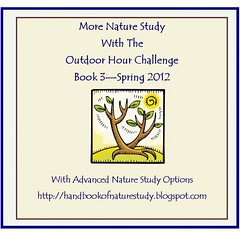
More Nature Study Book 3
Garden Flower - Blue Flag Iris
“Each iris flower has three side doors leading to the nectar wells; and the bees, in order to get the nectar, must brush off the pollen dust on their backs” Handbook of Nature Study
Inside Preparation Work:
- Read Lesson 157 in the Handbook of Nature Study (pages 571-574). View the diagram on page 573 showing the parts of the iris labeled.
- View these YouTube videos: Blue Flag and Iris and Bee.
- Advanced Study: You can determine what kind of native irises you have in your area by viewing the maps at the bottom of this page: USDA Iris.
- This lesson is valuable for learning about wild irises and garden irises as well. Take your outdoor time for this challenge and view an iris if possible. The lesson also suggests that observations of the flower can take place inside but the viewing of the bee visiting the iris is the most interesting way to learn about this flower. You may need to file this study away until you can visit an iris in person.
- Alternate activity: Spend time watching insects and flowers in your garden or at a near-by park. Use the information about the iris and the information you learned in the Poppy-Buttercup Challenge to make comparisons between flowers. Remember to use proper flower part vocabulary in your conversation. Ebook Users: You can use the Spring Flower notebook page if you would like as part of this challenge.
- Watch any pollinators in your yard and observe their behavior.
- Allow time for a nature journal entry where your child can sketch and record their iris study or complete a coloring page. This site may be helpful in carefully drawing the iris and labeling its parts: The Iris Flower (USDA). Advanced Study: Use colored pencils and draw your iris in your nature journal (see an example HERE). How about a video?
- Discuss any pollinators you viewed as part of this challenge and record any interesting thoughts in your nature journal. See the list of questions above.
- Advanced Study: If you live in the United States, you can use this website to determine what plants and pollinators you have in your neighborhood: Pollinator Partnership. View your guide to determine five plants that you can add to your garden to encourage pollinators to visit. If you already have native plants, make a list of them in your nature journal. Alternate activity: Record information in your nature journal for one native iris to your area.
Great Sunflower Project: If you enjoy watching bees visit your garden flowers, you may be interested in participating in this citizen science project. It is simple enough for even very young children to get involved with and it doesn’t take a lot of time. Click over to their website to learn more.
Blue Iris Time Lapse video (for fun).

Don't forget to share your Spring Splendor Walk blog entries with the Outdoor Hour Challenge Blog Carnival. All entries done in May are eligible for the next edition. The deadline for entries is 5/30/12 and you can send them directly to me: harmonyfinearts@yahoo.com.

No comments:
Post a Comment